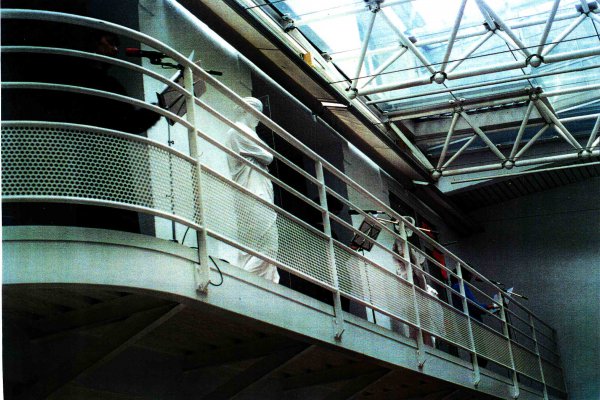Each work of the series Labyrinth of Languages is developed in a specific space. From this space, the live intervention of three broadcasters and several recordings, the work is developed as a labyrinthic relationship of languages in a real, virtual, mental space and time. Languages are here as coincident strata in the space of performance and in that of the radio broadcasting, in which the three-dimensional physical space where the action takes place live is projected - live or in a deferred way - to the electronic space of the radio. The work uses a self-referential text on the concept of the work, always interpreted in the language of the country, which here will be the German, by three speakers, according to a precise scheme-scores.
In 1990 we premiered at Rassegna AUDIOBOX, in Matera (Italia), the first version of the work, untitled Labirinto di linguaggi (http://expandedradio.net/labirinto-di-linguaggi/). It was broadcast live by RAI (AUDIOBOX). In 1991 we made the second version, Labyrinthe de langages (http://expandedradio.net/labyrinthe-de-langages/) , which took place in Casa de España in Paris (now Instituto Cervantes). The work was procuced and broadcast by the Atelier de Création Radiophonique (ACR) of France-Culture (Radio France). In 1993 the YLE of Finland produced and broadcast the third version of the series, Kielten Labirintii (http://expandedradio.net/kielten-labirintti/), performed live on Festival Wings of Sound in Helsinki.
A previous performance was made in 1989 by Concha Jerez for a Festival of Performance and Action Poetry organized in Peñíscola (Spain), which resulted in the original recordings in Spanish and English. As can be seen in the recordings of previous works, these recordings in English and Spanish of the first performance overlap with those of the local language. Also, some other sounds have been used (if only in the Finnish version). In the work that we propose for the Musikprotokoll will use as strata some of the materials of the previous works, along with new recordings and live performances. Acoustic spatialization is planned in multi-channel format.
In the course of the work, Concha Jerez would move through the space where it was performed, carrying a radio receiver on, hanging from the shoulder in the manner of a bag. It would also carry a kitchen vessel, with mirrors of methacrylate inside - on which the fragmented text of the work has been labeled or written. Those mirrors would be placed one by one on individual chairs spread over that space, accentuating interesting places for listening. Throughout the work, José Iges would incorporate other sound materials and control the acoustic spatialization of the ensemble.
Click here for more information: http://expandedradio.net/labirinto-di-linguaggi/




